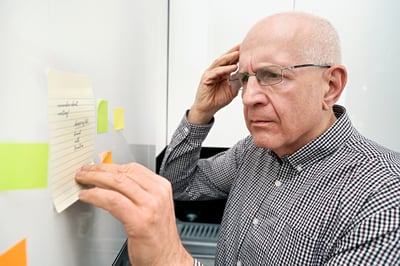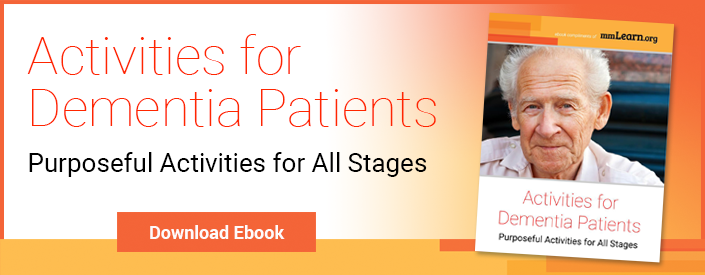 Today, approximately 5.8 million people in the U.S. have dementia. It’s no wonder so many caregivers are looking for tips on boosting seniors’ quality of life and finding activities for dementia patients
Today, approximately 5.8 million people in the U.S. have dementia. It’s no wonder so many caregivers are looking for tips on boosting seniors’ quality of life and finding activities for dementia patients
Only decades ago, people were still writing off dementia‑related behaviors to senility. Now researchers have an ever‑increasing understanding of the brain, which has allowed them to better identify new brain disorders, including the types of dementia.
Dementia is not a specific diagnosis on its own. Rather, dementia is a general term for any severe decline in mental abilities due to the brain's physical deterioration. Not all types of dementia are the same.
There are four common forms of clinical dementia:
- Alzheimer’s Disease
- Vascular dementia
- Dementia with Lewy Body
- Frontotemporal Dementia
Let's take a closer look at these common types of dementia.
Types of Dementia
1. Alzheimer's Disease
According to the Alzheimer’s Association, more than 5 million Americans are living with this disease. An individual is diagnosed every 67 seconds. Alzheimer’s Disease is the country's sixth‑leading cause of death.
While the precise causes of Alzheimer's disease are unknown, research indicates that it stems from a mix of the following:
- Hereditary factors
- Lifestyle factors
- Environmental factors
Mayo Clinic reports that in less than 1% of cases, a specific genetic change leads to the development of the disease.
Symptoms of Alzheimer's include the following:
- Memory loss
- Confusion
- Trouble communicating
- Anxiety
- Paranoia
While there is no cure, many therapies can improve the quality of life for people with Alzheimer's. Because of its prevalence, the U.S. government has prioritized Alzheimer's research, hoping to find a cure by 2025.
2. Vascular Dementia
Also referred to as "post‑stroke dementia" and "multi‑infarct dementia," vascular dementia claims the second spot on the list of most common types of dementia. According to some estimates, vascular dementia may account for as many as 20 percent of the total number of all dementia cases.
While vascular dementia occurs when stroke restricts blood flow to the brain, not all people with stroke will develop this type of dementia.
The symptoms of vascular dementia vary depending on what region of the brain is affected. Symptoms may include the following:
- Short‑term memory problems
- Getting lost in familiar areas
- Inappropriate laughter or crying
- Difficulty with concentration
- Money management problems
- Trouble following instructions
- Lack of bowel or bladder control
- Hallucinations
Vascular dementia shares risk factors for stroke, including smoking, diabetes, high cholesterol, and high blood pressure. And while there's no treatment for vascular dementia, early diagnosis and behavioral interventions can prevent further damage.
3. Lewy Body Dementia (LBD)
Also called cortical Lewy body disease or diffuse Lewy body disease, LBD affects an estimated 1.4 million people in the U.S. It is the third most common cause of dementia. Because the symptoms closely mimic other diseases like Alzheimer's and Parkinson's, LBD is frequently underdiagnosed.
LBD is caused by the appearance of abnormal proteins in nerve cells which impair and impede normal functioning.
Symptoms of LBD include the following:
- Sleep problems
- Memory loss
- Hallucinations
- Variations in alertness
While it can take up to two years for symptoms to reach levels where they can be diagnosed, early detection leads to better outcomes. There is no cure, but treatment methods include medication as well as non‑medical options, such as physical, speech, and occupational therapy.
4. Frontotemporal Degeneration (FTD)
FTD is also known as frontotemporal dementia, frontotemporal lobar degeneration (FTLD), or Pick's disease. It affects between 50,000 and 60,000 Americans, according to the Association for Frontotemporal Degeneration.
FTD differs from other types of dementia in two significant ways:
- While it affects a person's behavior, personality, language, and ability to function, memory is usually unaffected.
- It is also thought of as a "young" person's disease as the average diagnosis age is 60.
Symptoms of FTD include the following:
- Decreased inhibition
- Loss of motivation
- Reduced empathy
- Compulsive behaviors
- Anxiety
- Depression
Like other forms of dementia, frontotemporal dementia has no cure, but there are effective medical and non‑medical interventions for treating symptoms.
While any diseases or conditions that cause brain damage can be categorized as dementia, understanding these four main types and knowing what to look for can help caregivers ensure that their loved ones get prompt medical treatment.
For a more detailed look at the differences between these common types of dementia—including what they mean for patients and caregivers—watch this video presentation by geriatric psychologist Dr. Thomas Weiss.

